实例介绍
【实例简介】深度学习笔记
吴恩达关于深度学习的python编程教学,非常不错的人工智能学习书籍
【实例截图】
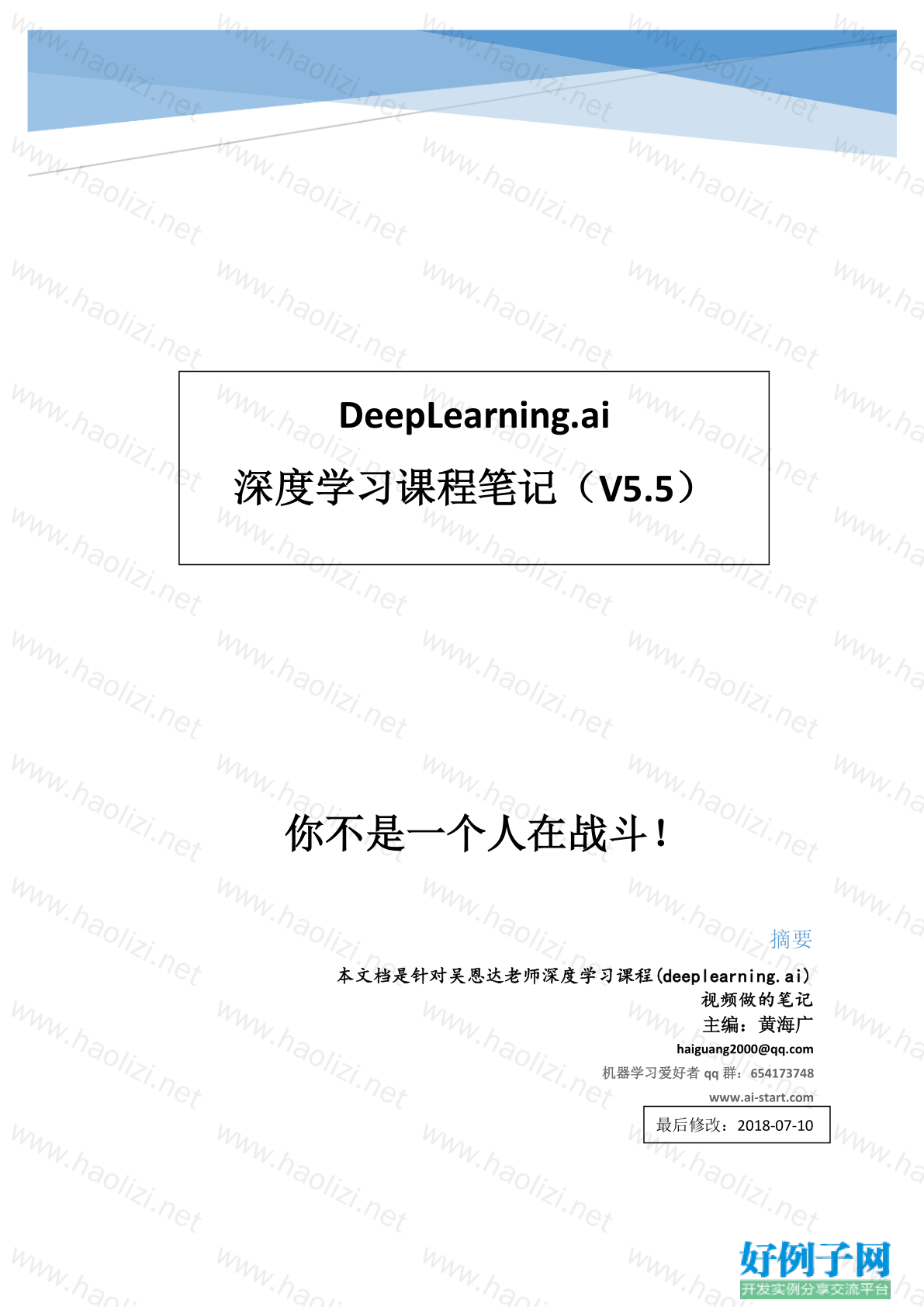

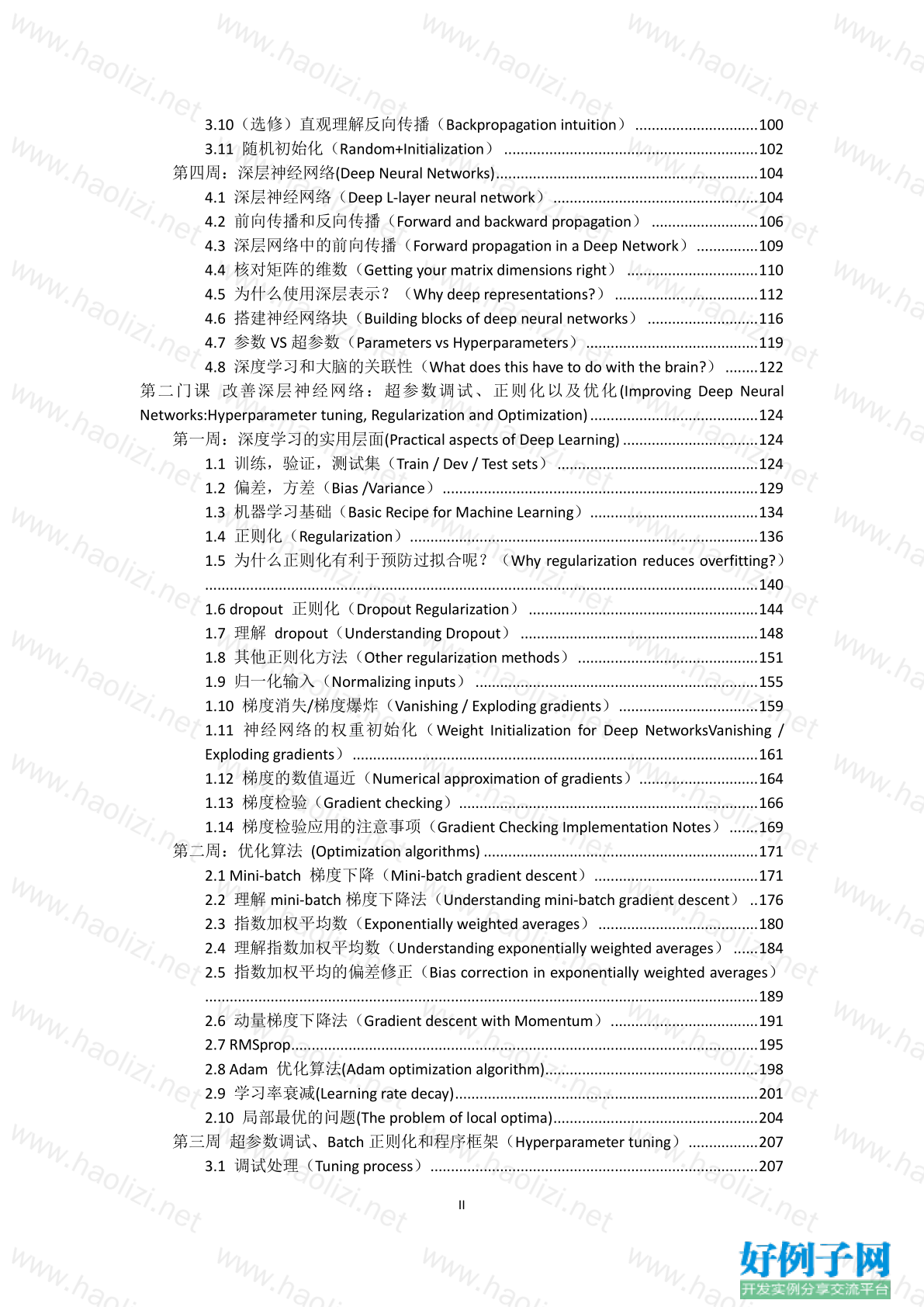
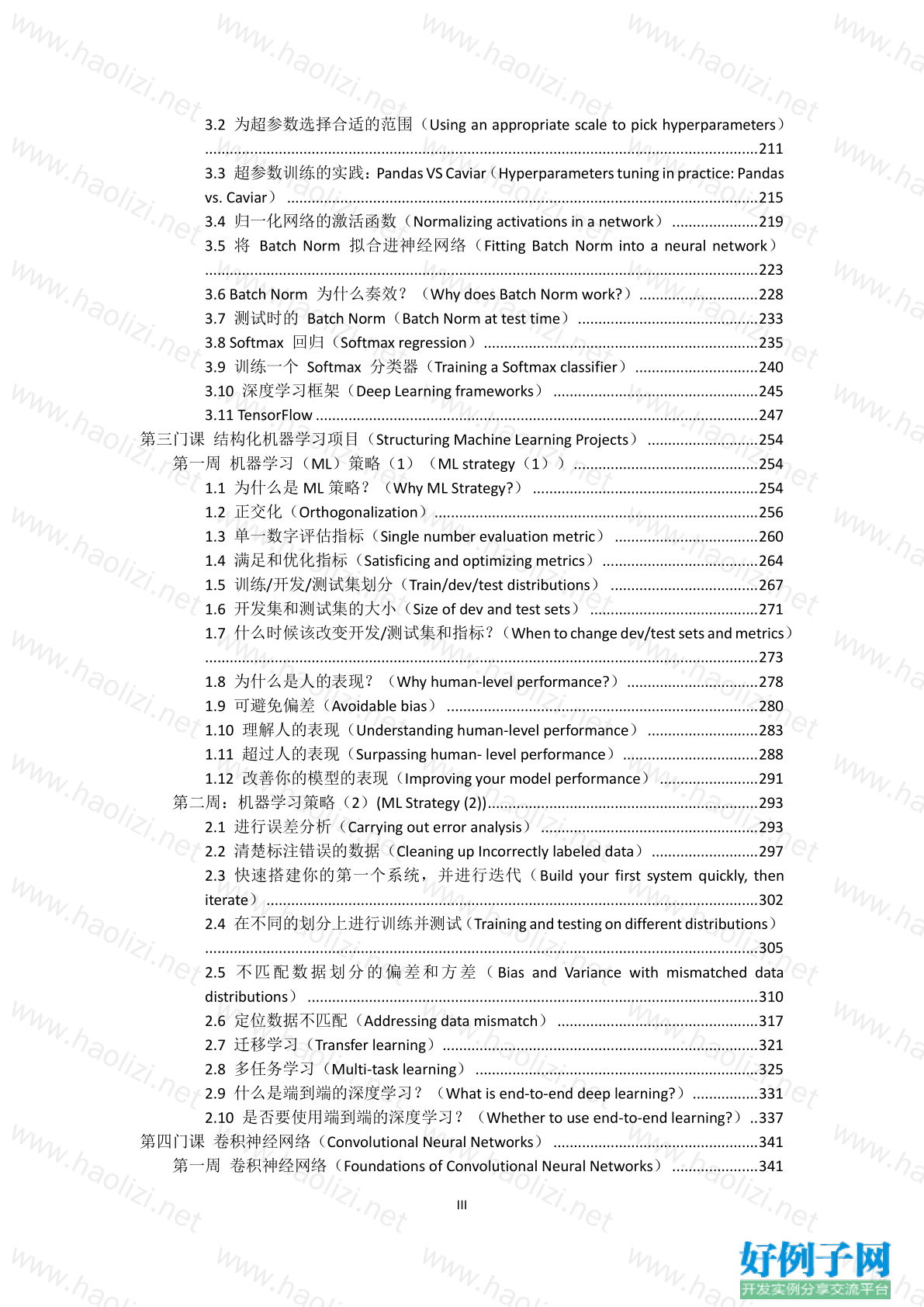
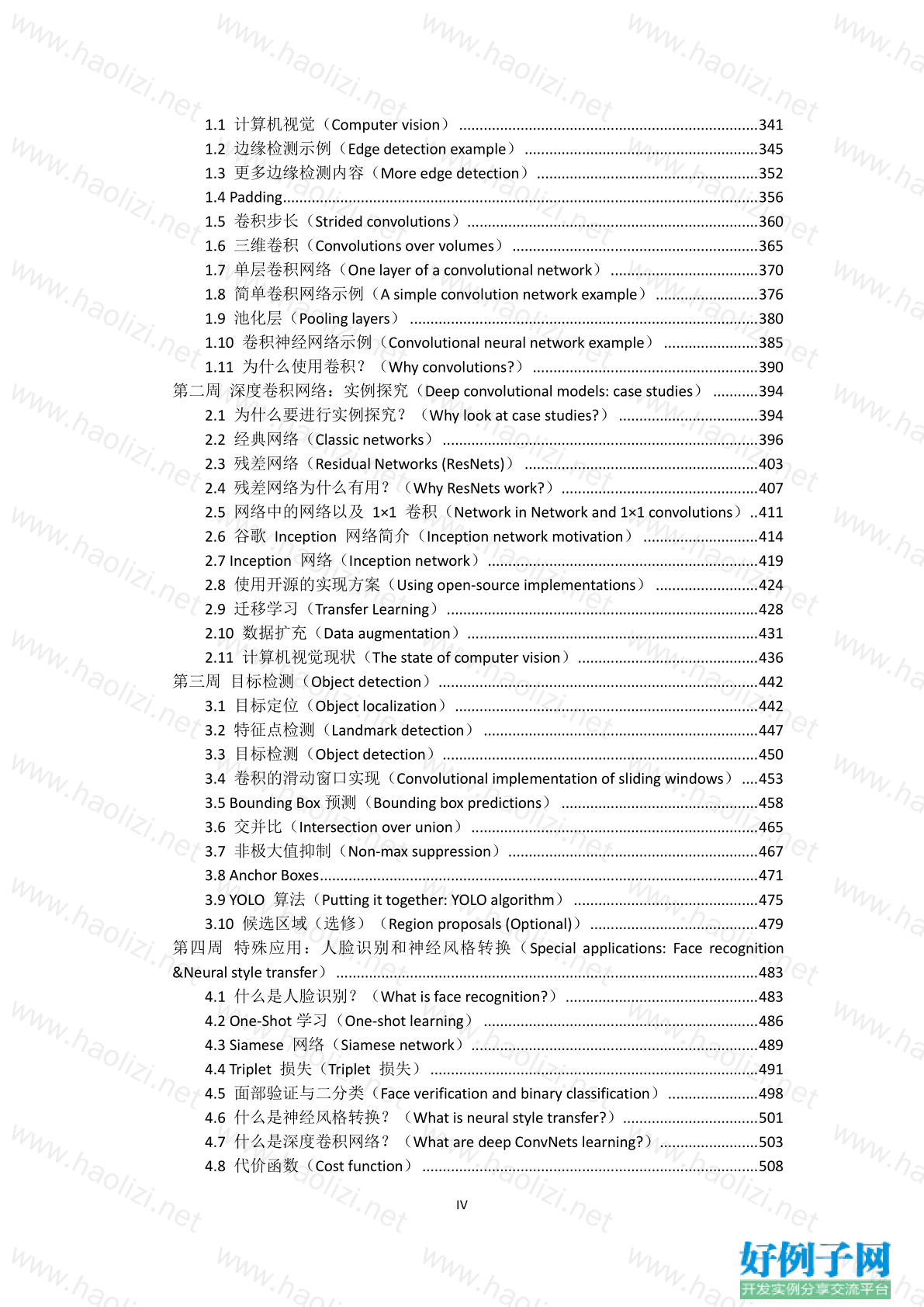
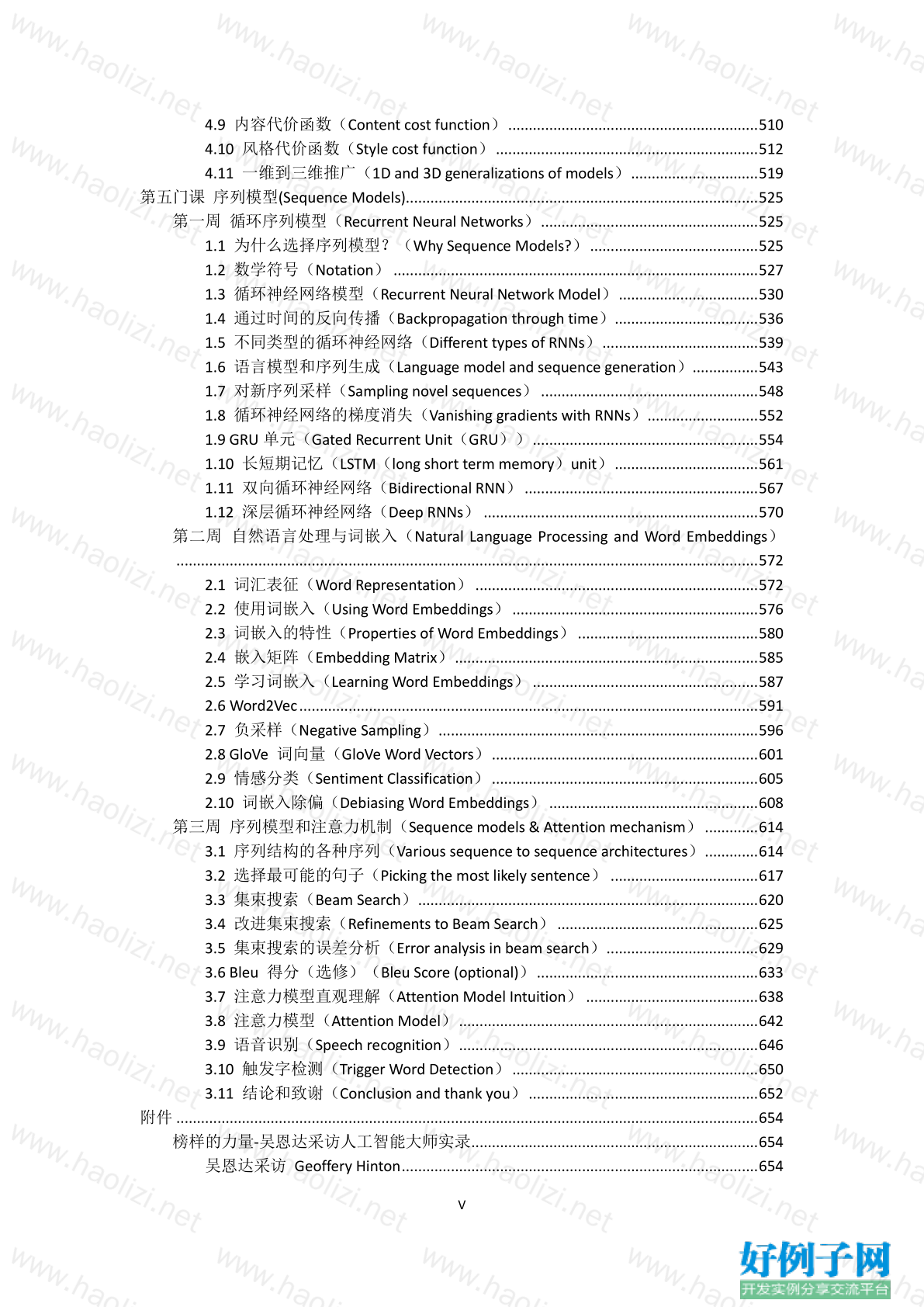

【核心代码】
目录
第一门课 神经网络和深度学习(Neural Networks and Deep Learning) ........................................ 1
第一周:深度学习引言(Introduction to Deep Learning) ........................................................ 1
1.1 欢迎(Welcome) .......................................................................................................... 1
1.2 什么是神经网络?(What is a Neural Network) ........................................................ 4
1.3 神经网络的监督学习(Supervised Learning with Neural Networks) ......................... 8
1.4 为什么深度学习会兴起?(Why is Deep Learning taking off?) .............................. 12
1.5 关于这门课(About this Course) .............................................................................. 16
1.6 课程资源(Course Resources) ................................................................................... 17
第二周:神经网络的编程基础(Basics of Neural Network programming) ........................... 18
2.1 二分类(Binary Classification) ................................................................................... 18
2.2 逻辑回归(Logistic Regression) ................................................................................. 22
2.3 逻辑回归的代价函数(Logistic Regression Cost Function) ................................ 24
2.4 梯度下降法(Gradient Descent) .......................................................................... 26
2.5 导数(Derivatives) ................................................................................................ 30
2.6 更多的导数例子(More Derivative Examples) .................................................... 32
2.7 计算图(Computation Graph) .............................................................................. 35
2.8 计算图的导数计算(Derivatives with a Computation Graph) ............................ 36
2.9 逻辑回归中的梯度下降(Logistic Regression Gradient Descent) ...................... 42
2.10 m 个样本的梯度下降(Gradient Descent on m Examples) .................................... 45
2.11 向量化(Vectorization) ............................................................................................ 48
2.12 向量化的更多例子(More Examples of Vectorization) .................................... 52
2.13 向量化逻辑回归(Vectorizing Logistic Regression) ................................................ 55
2.14 向量化 logistic 回归的梯度输出(Vectorizing Logistic Regression's Gradient)
......................................................................................................................................... 58
2.15 Python 中的广播(Broadcasting in Python) ...................................................... 61
2.16 关于 python _ numpy 向量的说明(A note on python or numpy vectors)参考
视频: ............................................................................................................................. 65
2.17 Jupyter/iPython Notebooks 快速入门(Quick tour of Jupyter/iPython Notebooks)
......................................................................................................................................... 69
2.18 (选修)logistic 损失函数的解释(Explanation of logistic regression cost function)
......................................................................................................................................... 73
第三周:浅层神经网络(Shallow neural networks) ............................................................... 77
3.1 神经网络概述(Neural Network Overview) ........................................................ 77
3.2 神经网络的表示(Neural Network Representation)........................................... 80
3.3 计算一个神经网络的输出(Computing a Neural Network's output) ................ 83
3.4 多样本向量化(Vectorizing across multiple examples) ...................................... 86
3.5 向量化实现的解释(Justification for vectorized implementation) ..................... 89
3.6 激活函数(Activation functions) ......................................................................... 91
3.7 为什么需要非线性激活函数?(why need a nonlinear activation function?) .. 94
3.8 激活函数的导数(Derivatives of activation functions) ....................................... 96
3.9 神经网络的梯度下降(Gradient descent for neural networks).......................... 98
II
3.10(选修)直观理解反向传播(Backpropagation intuition) .............................. 100
3.11 随机初始化(Random Initialization) .............................................................. 102
第四周:深层神经网络(Deep Neural Networks) ................................................................ 104
4.1 深层神经网络(Deep L-layer neural network) .................................................. 104
4.2 前向传播和反向传播(Forward and backward propagation) .......................... 106
4.3 深层网络中的前向传播(Forward propagation in a Deep Network) ............... 109
4.4 核对矩阵的维数(Getting your matrix dimensions right) ................................ 110
4.5 为什么使用深层表示?(Why deep representations?) ................................... 112
4.6 搭建神经网络块(Building blocks of deep neural networks) ........................... 116
4.7 参数 VS 超参数(Parameters vs Hyperparameters) .......................................... 119
4.8 深度学习和大脑的关联性(What does this have to do with the brain?) ........ 122
第二门课 改善深层神经网络:超参数调试、正则化以及优化(Improving Deep Neural
Networks:Hyperparameter tuning, Regularization and Optimization) ......................................... 124
第一周:深度学习的实用层面(Practical aspects of Deep Learning) ................................. 124
1.1 训练,验证,测试集(Train / Dev / Test sets) ................................................. 124
1.2 偏差,方差(Bias /Variance) ............................................................................. 129
1.3 机器学习基础(Basic Recipe for Machine Learning)......................................... 134
1.4 正则化(Regularization) ..................................................................................... 136
1.5 为什么正则化有利于预防过拟合呢?(Why regularization reduces overfitting?)
....................................................................................................................................... 140
1.6 dropout 正则化(Dropout Regularization) ........................................................ 144
1.7 理解 dropout(Understanding Dropout) .......................................................... 148
1.8 其他正则化方法(Other regularization methods) ............................................ 151
1.9 归一化输入(Normalizing inputs) ..................................................................... 155
1.10 梯度消失/梯度爆炸(Vanishing / Exploding gradients) .................................. 159
1.11 神经网络的权重初始化(Weight Initialization for Deep NetworksVanishing /
Exploding gradients) ................................................................................................... 161
1.12 梯度的数值逼近(Numerical approximation of gradients) ............................. 164
1.13 梯度检验(Gradient checking)......................................................................... 166
1.14 梯度检验应用的注意事项(Gradient Checking Implementation Notes) ....... 169
第二周:优化算法 (Optimization algorithms) ................................................................... 171
2.1 Mini-batch 梯度下降(Mini-batch gradient descent) ........................................ 171
2.2 理解 mini-batch 梯度下降法(Understanding mini-batch gradient descent) .. 176
2.3 指数加权平均数(Exponentially weighted averages) ....................................... 180
2.4 理解指数加权平均数(Understanding exponentially weighted averages) ...... 184
2.5 指数加权平均的偏差修正(Bias correction in exponentially weighted averages)
....................................................................................................................................... 189
2.6 动量梯度下降法(Gradient descent with Momentum) .................................... 191
2.7 RMSprop .................................................................................................................. 195
2.8 Adam 优化算法(Adam optimization algorithm).................................................... 198
2.9 学习率衰减(Learning rate decay) .......................................................................... 201
2.10 局部最优的问题(The problem of local optima) .................................................. 204
第三周 超参数调试、Batch 正则化和程序框架(Hyperparameter tuning) ................. 207
3.1 调试处理(Tuning process) ................................................................................ 207
III
3.2 为超参数选择合适的范围(Using an appropriate scale to pick hyperparameters)
....................................................................................................................................... 211
3.3 超参数训练的实践:Pandas VS Caviar(Hyperparameters tuning in practice: Pandas
vs. Caviar) ................................................................................................................... 215
3.4 归一化网络的激活函数(Normalizing activations in a network) ..................... 219
3.5 将 Batch Norm 拟合进神经网络(Fitting Batch Norm into a neural network)
....................................................................................................................................... 223
3.6 Batch Norm 为什么奏效?(Why does Batch Norm work?) ............................. 228
3.7 测试时的 Batch Norm(Batch Norm at test time) ............................................ 233
3.8 Softmax 回归(Softmax regression) ................................................................... 235
3.9 训练一个 Softmax 分类器(Training a Softmax classifier) .............................. 240
3.10 深度学习框架(Deep Learning frameworks) .................................................. 245
3.11 TensorFlow ............................................................................................................ 247
第三门课 结构化机器学习项目(Structuring Machine Learning Projects) ........................... 254
第一周 机器学习(ML)策略(1)(ML strategy(1)) ............................................. 254
1.1 为什么是 ML 策略?(Why ML Strategy?) ....................................................... 254
1.2 正交化(Orthogonalization)............................................................................... 256
1.3 单一数字评估指标(Single number evaluation metric) ................................... 260
1.4 满足和优化指标(Satisficing and optimizing metrics) ...................................... 264
1.5 训练/开发/测试集划分(Train/dev/test distributions) .................................... 267
1.6 开发集和测试集的大小(Size of dev and test sets) ......................................... 271
1.7 什么时候该改变开发/测试集和指标?(When to change dev/test sets and metrics)
....................................................................................................................................... 273
1.8 为什么是人的表现?(Why human-level performance?) ................................ 278
1.9 可避免偏差(Avoidable bias) ............................................................................ 280
1.10 理解人的表现(Understanding human-level performance) ........................... 283
1.11 超过人的表现(Surpassing human- level performance) ................................. 288
1.12 改善你的模型的表现(Improving your model performance) ........................ 291
第二周:机器学习策略(2)(ML Strategy (2)) .................................................................. 293
2.1 进行误差分析(Carrying out error analysis) ..................................................... 293
2.2 清楚标注错误的数据(Cleaning up Incorrectly labeled data) .......................... 297
2.3 快速搭建你的第一个系统,并进行迭代(Build your first system quickly, then
iterate) ........................................................................................................................ 302
2.4 在不同的划分上进行训练并测试(Training and testing on different distributions)
....................................................................................................................................... 305
2.5 不匹配数据划分的偏差和方差(Bias and Variance with mismatched data
distributions) .............................................................................................................. 310
2.6 定位数据不匹配(Addressing data mismatch) ................................................. 317
2.7 迁移学习(Transfer learning) ............................................................................. 321
2.8 多任务学习(Multi-task learning) ..................................................................... 325
2.9 什么是端到端的深度学习?(What is end-to-end deep learning?) ................ 331
2.10 是否要使用端到端的深度学习?(Whether to use end-to-end learning?) .. 337
第四门课 卷积神经网络(Convolutional Neural Networks) .................................................. 341
第一周 卷积神经网络(Foundations of Convolutional Neural Networks) ..................... 341
IV
1.1 计算机视觉(Computer vision) ......................................................................... 341
1.2 边缘检测示例(Edge detection example) ......................................................... 345
1.3 更多边缘检测内容(More edge detection) ...................................................... 352
1.4 Padding .................................................................................................................... 356
1.5 卷积步长(Strided convolutions)....................................................................... 360
1.6 三维卷积(Convolutions over volumes) ............................................................ 365
1.7 单层卷积网络(One layer of a convolutional network) .................................... 370
1.8 简单卷积网络示例(A simple convolution network example) ......................... 376
1.9 池化层(Pooling layers) ..................................................................................... 380
1.10 卷积神经网络示例(Convolutional neural network example) ....................... 385
1.11 为什么使用卷积?(Why convolutions?) ....................................................... 390
第二周 深度卷积网络:实例探究(Deep convolutional models: case studies) ........... 394
2.1 为什么要进行实例探究?(Why look at case studies?) .................................. 394
2.2 经典网络(Classic networks) ............................................................................. 396
2.3 残差网络(Residual Networks (ResNets)) ......................................................... 403
2.4 残差网络为什么有用?(Why ResNets work?) ................................................ 407
2.5 网络中的网络以及 1×1 卷积(Network in Network and 1×1 convolutions) .. 411
2.6 谷歌 Inception 网络简介(Inception network motivation) ............................ 414
2.7 Inception 网络(Inception network) .................................................................. 419
2.8 使用开源的实现方案(Using open-source implementations) ......................... 424
2.9 迁移学习(Transfer Learning) ............................................................................ 428
2.10 数据扩充(Data augmentation) ....................................................................... 431
2.11 计算机视觉现状(The state of computer vision) ............................................ 436
第三周 目标检测(Object detection) .............................................................................. 442
3.1 目标定位(Object localization) .......................................................................... 442
3.2 特征点检测(Landmark detection) ................................................................... 447
3.3 目标检测(Object detection) ............................................................................. 450
3.4 卷积的滑动窗口实现(Convolutional implementation of sliding windows) .... 453
3.5 Bounding Box 预测(Bounding box predictions) ................................................ 458
3.6 交并比(Intersection over union) ...................................................................... 465
3.7 非极大值抑制(Non-max suppression) ............................................................. 467
3.8 Anchor Boxes ........................................................................................................... 471
3.9 YOLO 算法(Putting it together: YOLO algorithm) ............................................. 475
3.10 候选区域(选修)(Region proposals (Optional)) ......................................... 479
第四周 特殊应用:人脸识别和神经风格转换(Special applications: Face recognition
&Neural style transfer) ....................................................................................................... 483
4.1 什么是人脸识别?(What is face recognition?) ............................................... 483
4.2 One-Shot 学习(One-shot learning) ................................................................... 486
4.3 Siamese 网络(Siamese network) ...................................................................... 489
4.4 Triplet 损失(Triplet 损失) ................................................................................ 491
4.5 面部验证与二分类(Face verification and binary classification) ...................... 498
4.6 什么是神经风格转换?(What is neural style transfer?) ................................. 501
4.7 什么是深度卷积网络?(What are deep ConvNets learning?)........................ 503
4.8 代价函数(Cost function) .................................................................................. 508
V
4.9 内容代价函数(Content cost function) ............................................................. 510
4.10 风格代价函数(Style cost function) ................................................................ 512
4.11 一维到三维推广(1D and 3D generalizations of models) ............................... 519
第五门课 序列模型(Sequence Models)...................................................................................... 525
第一周 循环序列模型(Recurrent Neural Networks) ..................................................... 525
1.1 为什么选择序列模型?(Why Sequence Models?) ......................................... 525
1.2 数学符号(Notation) ......................................................................................... 527
1.3 循环神经网络模型(Recurrent Neural Network Model) .................................. 530
1.4 通过时间的反向传播(Backpropagation through time)................................... 536
1.5 不同类型的循环神经网络(Different types of RNNs) ...................................... 539
1.6 语言模型和序列生成(Language model and sequence generation)................ 543
1.7 对新序列采样(Sampling novel sequences) ..................................................... 548
1.8 循环神经网络的梯度消失(Vanishing gradients with RNNs) ........................... 552
1.9 GRU 单元(Gated Recurrent Unit(GRU)) ....................................................... 554
1.10 长短期记忆(LSTM(long short term memory)unit) ................................... 561
1.11 双向循环神经网络(Bidirectional RNN) ......................................................... 567
1.12 深层循环神经网络(Deep RNNs) ................................................................... 570
第二周 自然语言处理与词嵌入(Natural Language Processing and Word Embeddings)
.............................................................................................................................................. 572
2.1 词汇表征(Word Representation) ..................................................................... 572
2.2 使用词嵌入(Using Word Embeddings) ............................................................ 576
2.3 词嵌入的特性(Properties of Word Embeddings) ............................................ 580
2.4 嵌入矩阵(Embedding Matrix) .......................................................................... 585
2.5 学习词嵌入(Learning Word Embeddings) ....................................................... 587
2.6 Word2Vec ................................................................................................................ 591
2.7 负采样(Negative Sampling) .............................................................................. 596
2.8 GloVe 词向量(GloVe Word Vectors) ................................................................. 601
2.9 情感分类(Sentiment Classification) ................................................................. 605
2.10 词嵌入除偏(Debiasing Word Embeddings) ................................................... 608
第三周 序列模型和注意力机制(Sequence models & Attention mechanism) ............. 614
3.1 序列结构的各种序列(Various sequence to sequence architectures) ............. 614
3.2 选择最可能的句子(Picking the most likely sentence) .................................... 617
3.3 集束搜索(Beam Search) ................................................................................... 620
3.4 改进集束搜索(Refinements to Beam Search) ................................................. 625
3.5 集束搜索的误差分析(Error analysis in beam search) ..................................... 629
3.6 Bleu 得分(选修)(Bleu Score (optional)) ...................................................... 633
3.7 注意力模型直观理解(Attention Model Intuition) .......................................... 638
3.8 注意力模型(Attention Model) ......................................................................... 642
3.9 语音识别(Speech recognition) ......................................................................... 646
3.10 触发字检测(Trigger Word Detection) ............................................................ 650
3.11 结论和致谢(Conclusion and thank you) ........................................................ 652
附件 .............................................................................................................................................. 654
榜样的力量-吴恩达采访人工智能大师实录 ...................................................................... 654
吴恩达采访 Geoffery Hinton ....................................................................................... 654
VI
吴恩达采访 Ian Goodfellow ........................................................................................ 664
吴恩达采访 Ruslan Salakhutdinov .............................................................................. 670
吴恩达采访 Yoshua Bengio ......................................................................................... 676
吴恩达采访 林元庆 ..................................................................................................... 683
吴恩达采访 Pieter Abbeel ........................................................................................... 687
吴恩达采访 Andrej Karpathy ....................................................................................... 692
深度学习符号指南(原课程翻译) ................................................................................... 698
机器学习的数学基础 ........................................................................................................... 700
高等数学 ....................................................................................................................... 700
线性代数 ....................................................................................................................... 708
概率论和数理统计 ....................................................................................................... 718
相关软件
小贴士
感谢您为本站写下的评论,您的评论对其它用户来说具有重要的参考价值,所以请认真填写。
- 类似“顶”、“沙发”之类没有营养的文字,对勤劳贡献的楼主来说是令人沮丧的反馈信息。
- 相信您也不想看到一排文字/表情墙,所以请不要反馈意义不大的重复字符,也请尽量不要纯表情的回复。
- 提问之前请再仔细看一遍楼主的说明,或许是您遗漏了。
- 请勿到处挖坑绊人、招贴广告。既占空间让人厌烦,又没人会搭理,于人于己都无利。
关于好例子网
本站旨在为广大IT学习爱好者提供一个非营利性互相学习交流分享平台。本站所有资源都可以被免费获取学习研究。本站资源来自网友分享,对搜索内容的合法性不具有预见性、识别性、控制性,仅供学习研究,请务必在下载后24小时内给予删除,不得用于其他任何用途,否则后果自负。基于互联网的特殊性,平台无法对用户传输的作品、信息、内容的权属或合法性、安全性、合规性、真实性、科学性、完整权、有效性等进行实质审查;无论平台是否已进行审查,用户均应自行承担因其传输的作品、信息、内容而可能或已经产生的侵权或权属纠纷等法律责任。本站所有资源不代表本站的观点或立场,基于网友分享,根据中国法律《信息网络传播权保护条例》第二十二与二十三条之规定,若资源存在侵权或相关问题请联系本站客服人员,点此联系我们。关于更多版权及免责申明参见 版权及免责申明



网友评论
我要评论